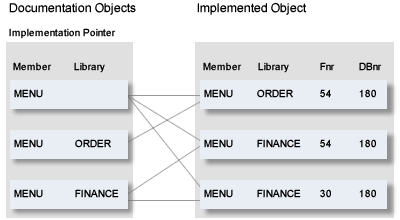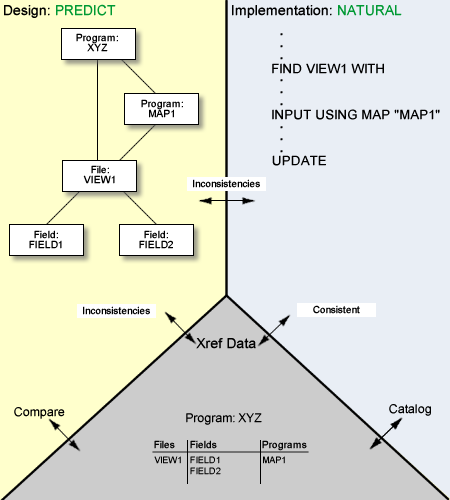This document covers the following topics:
The Predict data dictionary system helps to manage complex information processing systems by providing functions that retrieve information on its internal structure and properties of its components. Information can be retrieved online or in batch mode. Essentially three types of information can be retrieved from the dictionary.
Information on Attributes of Individual Objects
Most retrieval types report on the attributes of individual
objects. Information on any number of objects can be retrieved in one run.
Information on the Associations of Objects
Retrieving information on the associations of objects means
retrieving information on the structure of the information processing system,
for example which programs belong to a system, and which files are used by
these programs.
Information on the Implementation of Objects
For example whether an object that is documented in the
dictionary is already implemented. Active retrieval functions as well as
features of standard retrieval types provide information on the implementation
of objects. The section
Retrieving
Information from XRef Data describes in more detail all options to
retrieve information on the implementation of a system and compare this
information with documentation data.
To determine precisely which information is to be retrieved from the dictionary the following types of parameters are used:
Selection Criteria
Retrieval operations can be executed for single objects or
for groups of objects. Selection criteria determine which objects are to be
included in a report.
Retrieval Type
The retrieval type determines the type of information to be
retrieved from the dictionary.
Output Mode
In addition to the retrieval type,an output mode must be
specified. The output mode determines how information retrieved from the
dictionary is output and whether objects can be selected for further
processing.
Output Options
The selection criteria and the retrieval type determine the
information collected by Predict. Output options can then be used to determine
which information is actually contained in a report.
Retrieval Models
The retrieval type Execute retrieval model reports on the
structure of an information processing system. It can be specified exactly
which part of a metadata model is to be evaluated.
See the section Retrieval in the Predict Reference documentation.
Predict retrieval and active retrieval functions evaluate XRef data and documentation data, whereby retrieval functions start on the documentation side and active retrieval functions start on the XRef side.
To evaluate (and compare) information on objects stored as documentation data and as XRef data, Predict must know which documentation objects belong to which record in XRef data. This connection between the documentation and the XRef data is established with the implementation pointer of documentation objects (member name, library name, user system file number and user system database number).
If the same member is used in several libraries, multiple documentation of this member can be avoided by omitting the library name. Predict then finds out for itself all the libraries in which this member exists.

The parameters Implementation Library and Implementation DBNR/FNR can be set in the Maintenance Options screen of the General Defaults menu and apply when maintaining program objects.
See Using Implementation Pointers to Establish a Connection between Documentation and XRef Data in the section Active Retrieval in the Predict Reference documentation.
Documentation data alone does not necessarily say much about what has been implemented. It can exist without a single line of code having been written or differ significantly from what has been implemented. It is the XRef data that completes the picture by documenting what has actually been implemented.
XRef data is of interest to various groups of users: programmers, system analysts, project leaders, database administrators, data dictionary administrators, computer auditors, etc. However, each of these groups requires the XRef data evaluated in different ways. The following two sections contain some hints on how XRef data might be used.
The LIST XREF command provides
information on a specific application which can be used to monitor the
application. Errors can be detected (unused programs) and opportunities for
optimization (reducing the number of variables) are given in early development
phases. The impact of program changes can be estimated easily (for example, how
many programs must be modified when a field or variable is changed).
The following kinds of evaluation are available:
How often an object (program, variable, Copy Code, error number or processing rule) is used;
How a program is used, including recursive invocation structures;
Which objects are used by a program;
Which objects are available but not used (for example, which programs are not invoked by any other programs);
Which files are used, which of their fields are used, and how the fields are used (as counter fields or for reading, storing, searching or updating) in data areas;
All information about a program (use of programs, files, fields, variables, work files, retained sets, Copy Code, printers and error numbers, the source code of the program and its documentation in the Predict data dictionary.
Which programs were cataloged when, by whom and from which terminal.
The functions of Natural LIST XREF can be called from a menu or with a command.

Predict active retrieval functions evaluate XRef data across several applications.
When documentation data is evaluated, implementation data can also be output if required. The date when the documentation was last altered shows if changes to programs have been carried out in the documentation. In this way, the state of both the documentation and the implementation of an application can be evaluated.
Comparing the documentation data and the implementation also allows the detection of possible errors, such as descriptor fields that are not used. Section Comparison in the External Objects in Predict documentation describes how documentation and implementation are compared.
According to the type of function, the evaluation can be restricted either by specifying implementation data (member name, library name) or documentation data (object name) as selection criteria.
The following types of evaluation are available:
Which objects are implemented, including an indication of the documented entries;
How often an object is used (field, file, external program or verification);
Which objects are implemented but not documented;
Which objects are documented but not implemented;
Which members use documented objects (verifications, files, and fields);
The files defined as being used by a member and the files that are actually used;
The programs defined as being used in an application and the members that are actually used.
Using these evaluations, differences between the real implementation of a system and its documentation in Predict can be detected and resolved (see also the diagram above).
XRef data can be evaluated on its own or in conjunction with descriptive information stored in data dictionary objects.
Two methods are provided for retrieving XRef data independently of information stored in data dictionary objects:
XRef data written for members in the current Natural library is evaluated with the LIST XREF command. This method is described in the section LIST XREF for Natural in the Predict Reference documentation.
XRef data that was generated by Adabas Native SQL, Adabas SQL Server, the Predict preprocessor or the function CREATE DBRM of Natural for DB2 is evaluated with the LIST XREF for 3GL command of Predict. The LIST XREF command for 3GL is described in the section LIST XREF for Third Generation Languages in the Predict Reference documentation.
Again, two methods can be used to evaluate XRef data in connection with information stored in Predict documentation objects:
Predict active retrieval functions compare XRef data with the corresponding information in Predict documentation objects. This method is described in the section Active Retrieval in the Predict Reference documentation.
With Predict retrieval functions, set the parameter Show implementation in the output options to Y to display the implementation of a documentation object, or set the parameter Mark implementation to Y to mark implemented objects with an asterisk. Information on the implementation is taken from XRef data.
What is meant by implemented depends on the object type.
The following databases are regarded as implemented:
type A and connected to a physical Adabas database,
type D and connected to a physical DB2 database,
type P with a DBnr defined in the NTDB macro as an Entire System Server database,
type I.
- dataspace
A dataspace is regarded as implemented if a DB2 tablespace or SQL/DS DBspace has been generated from the Predict dataspace.
- file
A file is regarded as implemented if
any kind of copy code has been generated for a file or
the file is connected to an external object.
- program
A program is regarded as implemented if XRef data exists.
Note:
This does not apply to programs of type R (SQL procedure) and U (Database function). Both these types are regarded as implemented, if a DB2 procedure or function has been generated from the Predict program object.- storagespace
A storagespace is regarded as implemented if a DB2 storagegroup has been generated from the Predict storagespace.
- system
A system is regarded as implemented if XRef data exists for a program in the library documented by the system.
- verification
A verification is regarded as implemented if the rule of the verification is used in a map and XRef data exists.
Retrieval functions performed on XRef data often produce a list of objects that needs further processing, such as programs to be maintained or cataloged. Predict can save the output list of XRef data retrieval in a set for further processing. Sets can be used to share work among members of a project team and for communicating exactly what work needs to be done.
The following rules apply when working with sets:
Sets are created by setting the Save set option in a retrieval menu to Y or by using the function Create new sets of LIST XREF.
Sets can contain Natural objects of all types. Members stored in sets can be cataloged, checked or stowed, their contents can be edited or listed directly from the set.
Sets can be displayed, purged, sent to another user, merged, subtracted or intersected. When a set is sent, a short comment can be included that will appear when the set is displayed at the terminal of the recipient.
Sets are saved separately for each user and each Natural library. Any user defined in Predict can create and use up to ninety-nine sets in each library.
Note:
Sets can also be used in the Natural utilities NATUNLD and
SYSMAIN and in Natural ISPF.
Whenever a Copy Code is changed, all programs that use the Copy Code may need to be changed accordingly. The LIST XREF function Copy code referenced in programs can be used to find out which programs are affected. If the types and names of these programs are saved as a set, a single function can then be used to edit the contents of all the programs, one after another, and change them to match the changed Copy Code.
All members contained in the set can then be recataloged using a single function.
Section LIST XREF for Natural in the Predict Reference documentation contains a complete description of handling sets.